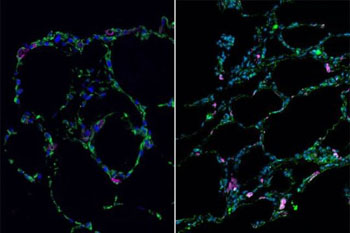3D Bioengineering Generates Lung Tissue for Personalized Disease Modeling
By LabMedica International staff writers
Posted on 28 Sep 2016
Lung disease researchers have developed a novel three-dimensional (3D) culture method for transforming stem cells into lung-like tissue that can be used to study diseases including idiopathic pulmonary fibrosis (IPF), which has traditionally been difficult to study using conventional methods.Posted on 28 Sep 2016
Investigators at the University of California, Los Angeles (USA) reported in the September 15, 2016, online edition of the journal Stem Cells Translational Medicine that they had coated hydrogel microbeads with stem cells taken from adult lungs. The coated beads were cultured in microwells where they developed into miniature lung organoids. These structures could be modified to contain multiple lung cell types assembled into the correct anatomical location, thereby allowing cell-cell contact and recapitulating the lung microenvironment.

Image: Three-dimensional (3D) bioengineered lung-like tissue (left) resembles adult human lung (right) (Photo courtesy of UCLA).
Treatment of lung organoids with transforming growth factor-beta-1 resulted in morphologic scarring typical of that seen in IPF but not seen in two-dimensional (2D) IPF fibroblast cultures. IPF is a chronic lung disease characterized by scarring of the lungs. The scarring makes the lungs thick and stiff, which over time results in progressively worsening shortness of breath and impaired transport of oxygen to the brain and vital organs.
"While we have not built a fully functional lung, we have been able to take lung cells and place them in the correct geometrical spacing and pattern to mimic a human lung," said senior author Dr. Brigitte Gomperts, associate professor of pediatric hematology/oncology at the University of California, Los Angeles. "This is the basis for precision medicine and personalized treatments."
Related Links:
University of California, Los Angeles













